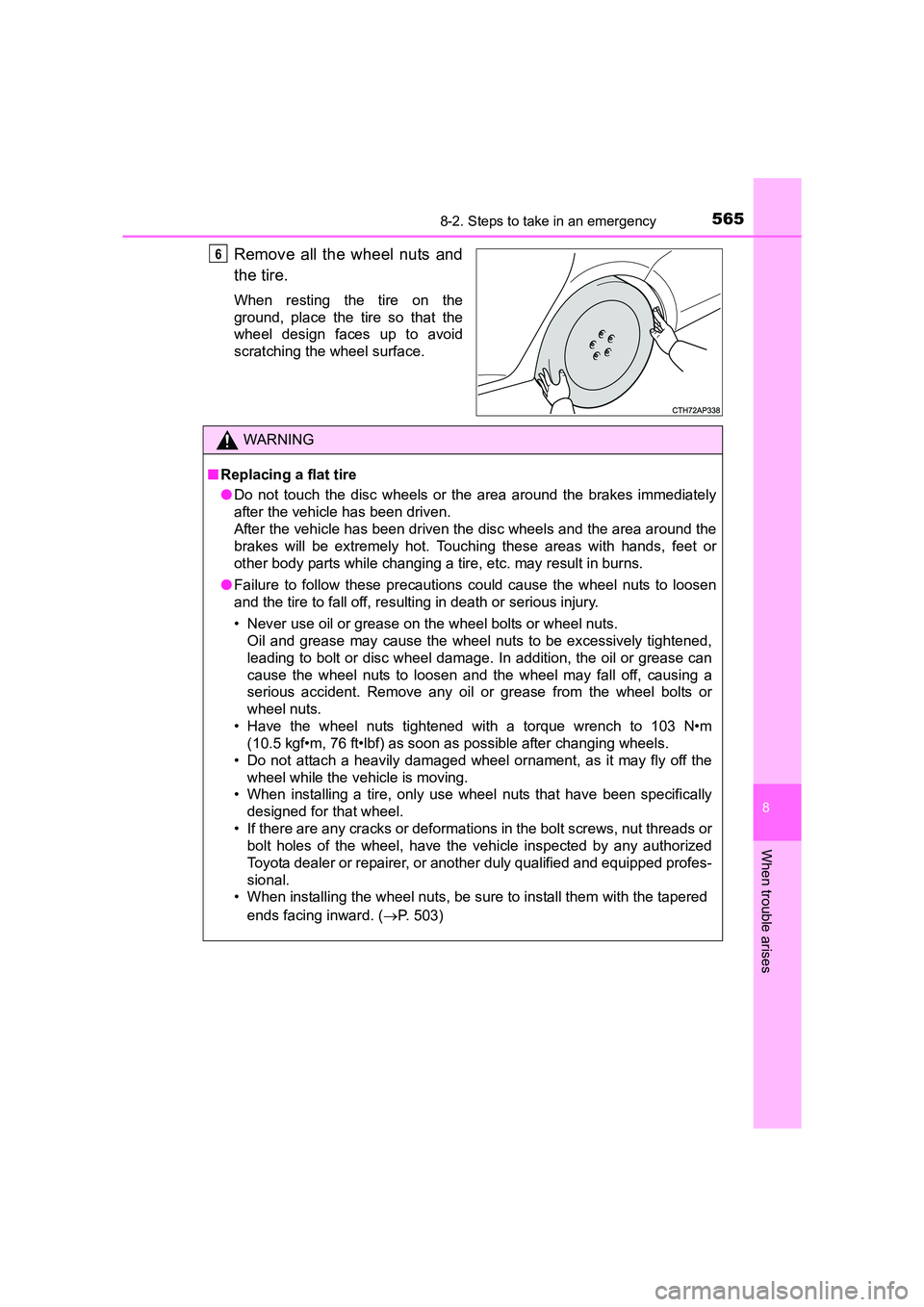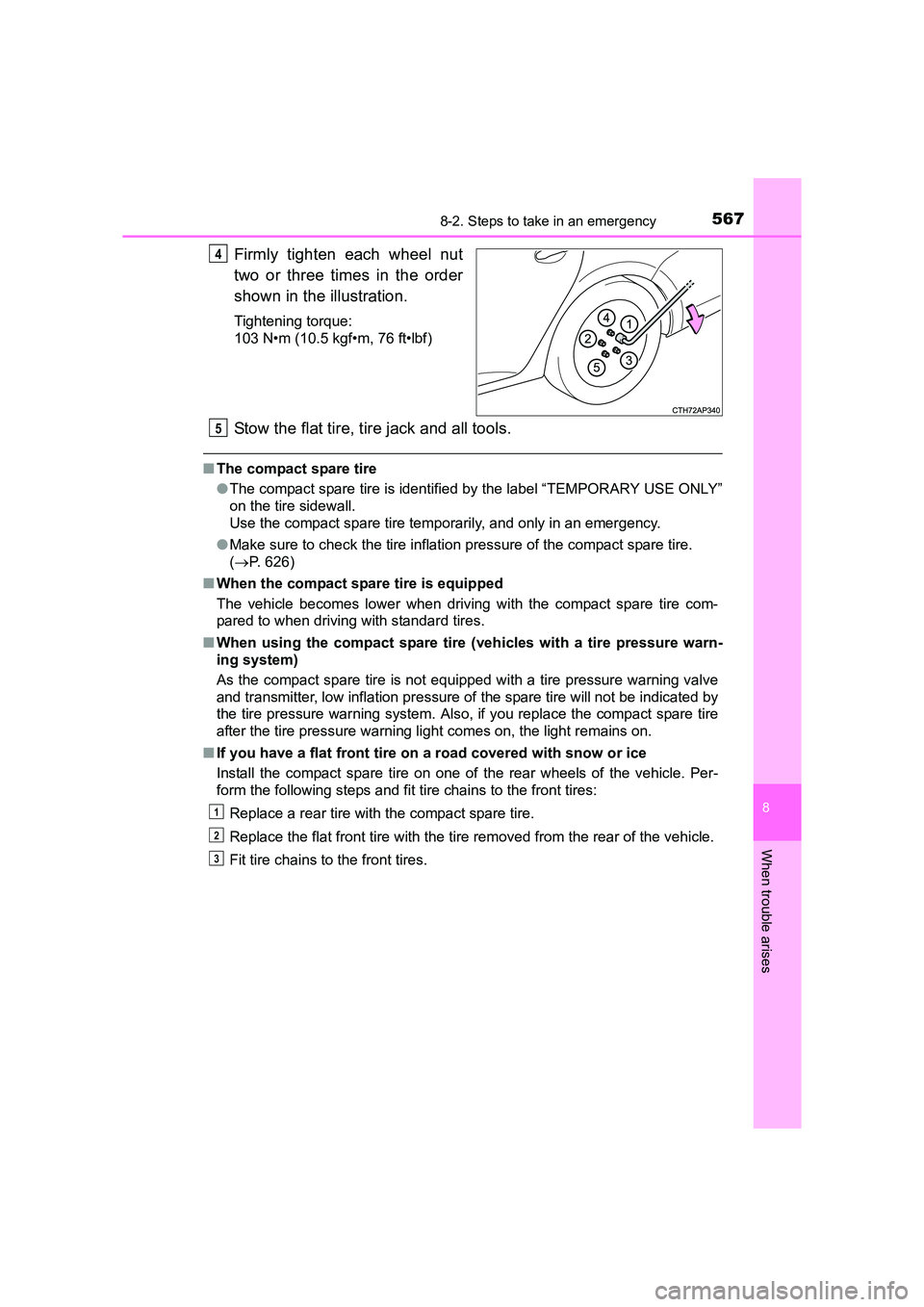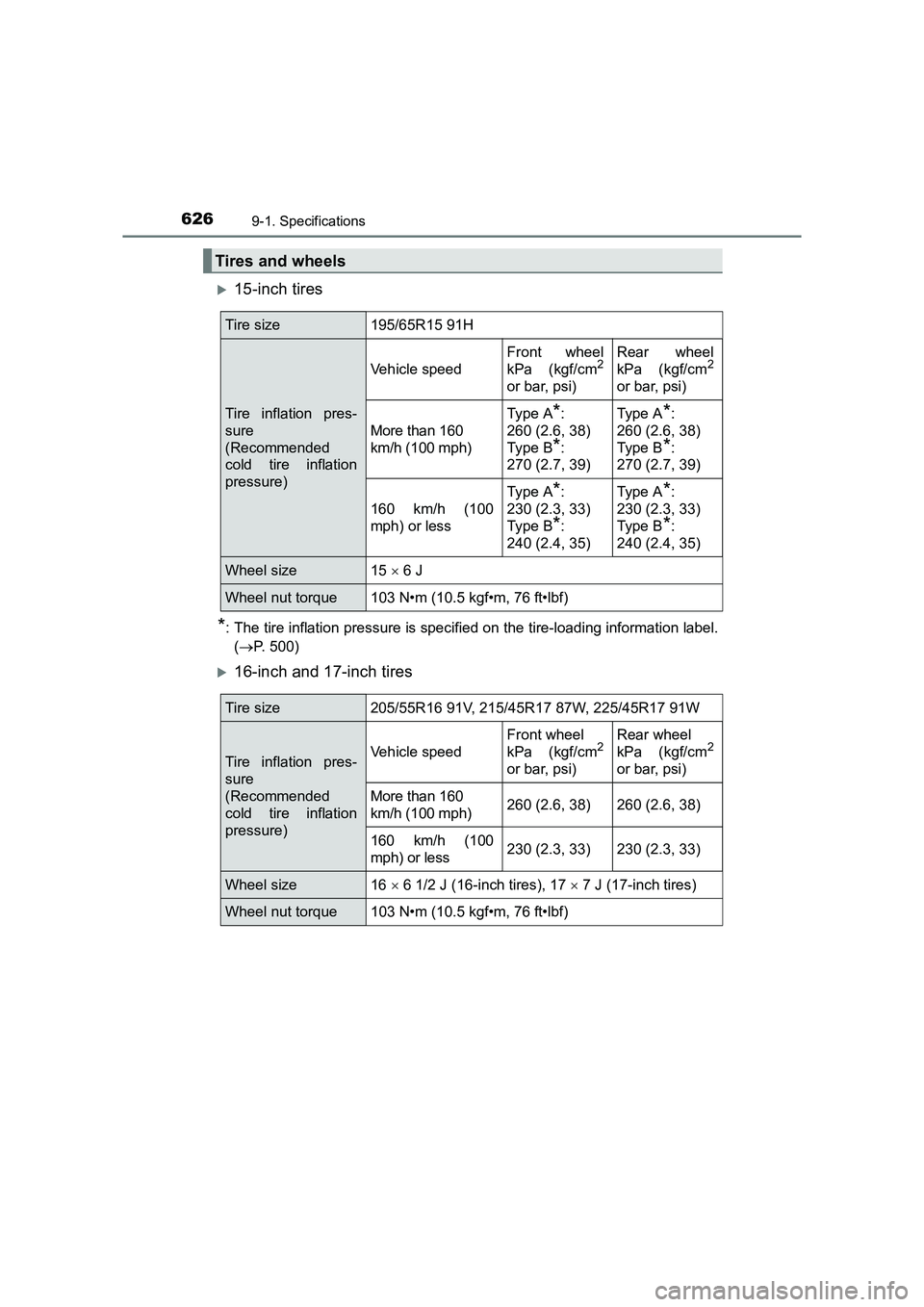Page 565 of 660

5658-2. Steps to take in an emergency
AURIS Touring Sports_EE (12K53E)
8
When trouble arises
Remove all the wheel nuts and
the tire.
When resting the tire on the
ground, place the tire so that the
wheel design faces up to avoid
scratching the wheel surface.
6
WARNING
■ Replacing a flat tire
●Do not touch the disc wheels or the area around the brakes immediately
after the vehicle has been driven.
After the vehicle has been driven the disc wheels and the area around the
brakes will be extremely hot. Touching these areas with hands, feet or
other body parts while changing a tire, etc. may result in burns.
● Failure to follow these precautions could cause the wheel nuts to loosen
and the tire to fall off, resulting in death or serious injury.
• Never use oil or grease on the wheel bolts or wheel nuts.
Oil and grease may cause the wheel nuts to be excessively tightened,
leading to bolt or disc wheel damage. In addition, the oil or grease can
cause the wheel nuts to loosen and the wheel may fall off, causing a
serious accident. Remove any oil or grease from the wheel bolts or
wheel nuts.
• Have the wheel nuts tightened with a torque wrench to 103 N•m (10.5 kgf•m, 76 ft•lbf) as soon as possible after changing wheels.
• Do not attach a heavily damaged wheel ornament, as it may fly off the wheel while the vehicle is moving.
• When installing a tire, only use wheel nuts that have been specifically
designed for that wheel.
• If there are any cracks or deformations in the bolt screws, nut threads or bolt holes of the wheel, have the vehicle inspected by any authorized
Toyota dealer or repairer, or another duly qualified and equipped profes-
sional.
• When installing the wheel nuts, be sure to install them with the tapered
ends facing inward. ( →P. 503)
Page 567 of 660

5678-2. Steps to take in an emergency
AURIS Touring Sports_EE (12K53E)
8
When trouble arises
Firmly tighten each wheel nut
two or three times in the order
shown in the illustration.
Tightening torque:
103 N•m (10.5 kgf•m, 76 ft•lbf)
Stow the flat tire, tire jack and all tools.
■The compact spare tire
●The compact spare tire is identified by the label “TEMPORARY USE ONLY”
on the tire sidewall.
Use the compact spare tire temporarily, and only in an emergency.
● Make sure to check the tire inflation pressure of the compact spare tire.
(→ P. 626)
■ When the compact spare tire is equipped
The vehicle becomes lower when driving with the compact spare tire com-
pared to when driving with standard tires.
■ When using the compact spare tire ( vehicles with a tire pressure warn-
ing system)
As the compact spare tire is not equipped with a tire pressure warning valve
and transmitter, low inflation pressure of the spare tire will not be indicated by
the tire pressure warning system. Also, if you replace the compact spare tire
after the tire pressure warning light comes on, the light remains on.
■ If you have a flat front tire on a road covered with snow or ice
Install the compact spare tire on one of the rear wheels of the vehicle. Per-
form the following steps and fit tire chains to the front tires:
Replace a rear tire with the compact spare tire.
Replace the flat front tire with the tire removed from the rear of the vehicle.
Fit tire chains to the front tires.
4
5
1
2
3
Page 626 of 660

6269-1. Specifications
AURIS Touring Sports_EE (12K53E)
�X15-inch tires
*: The tire inflation pressure is specified on the tire-loading information label.
( → P. 500)
�X16-inch and 17-inch tires
Tires and wheels
Tire size195/65R15 91H
Tire inflation pres-
sure
(Recommended
cold tire inflation
pressure)
Vehicle speed
Front wheel
kPa (kgf/cm2
or bar, psi)
Rear wheel
kPa (kgf/cm2
or bar, psi)
More than 160
km/h (100 mph)
Type A*:
260 (2.6, 38)
Type B
*:
270 (2.7, 39)
Type A*:
260 (2.6, 38)
Type B
*:
270 (2.7, 39)
160 km/h (100
mph) or less
Type A*:
230 (2.3, 33)
Type B
*:
240 (2.4, 35)
Type A*:
230 (2.3, 33)
Type B
*:
240 (2.4, 35)
Wheel size15 × 6 J
Wheel nut torque103 N•m (10.5 kgf•m, 76 ft•lbf)
Tire size205/55R16 91V, 215/45R17 87W, 225/45R17 91W
Tire inflation pres-
sure
(Recommended
cold tire inflation
pressure)Vehicle speed
Front wheel
kPa (kgf/cm2
or bar, psi)
Rear wheel
kPa (kgf/cm2
or bar, psi)
More than 160
km/h (100 mph)260 (2.6, 38)260 (2.6, 38)
160 km/h (100
mph) or less230 (2.3, 33)230 (2.3, 33)
Wheel size16 × 6 1/2 J (16-inch tires), 17 × 7 J (17-inch tires)
Wheel nut torque103 N•m (10.5 kgf•m, 76 ft•lbf)
Page 627 of 660
6279-1. Specifications
AURIS Touring Sports_EE (12K53E)
9
Vehicle specifications
�XCompact spare tire
■When towing a trailer
Add 20.0 kPa (0.2 kgf/cm2 or bar, 3 psi) to the recommended tire inflation
pressure and drive at speeds below 100 km/h (62 mph).
Tire sizeT125/70D17 98M
Tire inflation pressure
(Recommended cold
tire inflation pressure)
420 kPa (4.2 kgf/cm2 or bar, 60 psi)
Wheel size17 × 4 T
Wheel nut torque103 N•m (10.5 kgf•m, 76 ft•lbf)